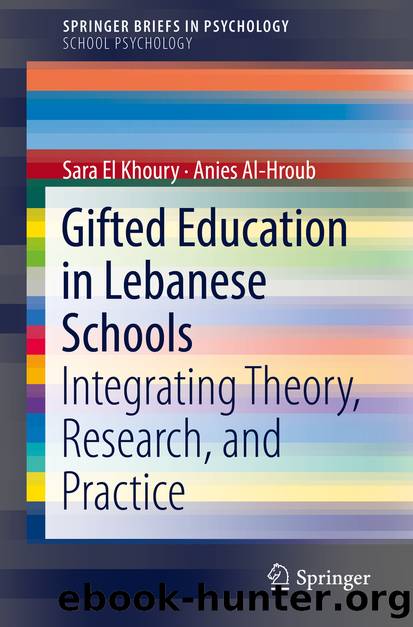Gifted Education in Lebanese Schools by Sara El Khoury & Anies Al-Hroub

Author:Sara El Khoury & Anies Al-Hroub
Language: eng
Format: epub
Publisher: Springer International Publishing, Cham
3.5.1 Misconceptions and Misdiagnosis
There is a major underrepresentation of gifted students in schools. Ford and Harmon (2002) stated that the main reason for this underrepresentation is, as he calls it, a “cognitive deficit perspective” which influences the access of gifted, culturally diverse students into gifted programs. This perspective assumes that students, who are economically disadvantaged or who come from minority populations, are “cognitively inferior,” because they fail to meet the traditional criteria for placement in gifted programs (i.e., scoring on the 97th percentile or above), and as a result, these students are underrepresented in gifted programs. This underrepresentation is estimated to be about 30–70% relative to their percentage in the population (Gabelko & Sosniak, 2002). If so, this implies that most schools are using this narrow and limiting cognitive deficit hypothesis definition of giftedness and intelligence (Ford et al., 2008). Bernal (2002) concurs with this and adds that this definition has major limitations because it does not take into consideration differing cultural factors in determining gifted cognitive abilities. Because of this continuing widespread belief, “identification procedures in most school districts (about 90%) still heavily rely on the scores of standardized tests, a practice that limits the access of culturally diverse students to programs for the gifted and keeps the demographics of these programs mostly White” (Ford & Harmon, 2001, p. 62). This presents a big problem for gifted minority students. According to Sarouphim and Maker (2010), scholars have called for a paradigm shift in identification procedures.
This is not the only problem. There is also the issue of inadequate policies and practices that also plays a role in the underrepresentation of gifted students from minority groups. Some policies in the United States, for example, require that gifted education screening must first begin with a teacher referral, and this poses a problem because teachers (even culturally diverse teachers) under-refer minority students for gifted services (Colangelo & Davis, 2003). This is problematic especially if teacher referral is the only recruitment step, because teacher referrals are often subjective and rely heavily on individual expectations and teachers’ perceptions of students (Colangelo & Davis, 2003). It is even more problematic if the teachers themselves are unclear about what defines a gifted student and if there is no general consensus surrounding the definition of giftedness.
Download
This site does not store any files on its server. We only index and link to content provided by other sites. Please contact the content providers to delete copyright contents if any and email us, we'll remove relevant links or contents immediately.
The Art of Coaching Workbook by Elena Aguilar(51004)
Trainspotting by Irvine Welsh(21524)
Twilight of the Idols With the Antichrist and Ecce Homo by Friedrich Nietzsche(18515)
Fangirl by Rainbow Rowell(9109)
Periodization Training for Sports by Tudor Bompa(8175)
Change Your Questions, Change Your Life by Marilee Adams(7641)
This Is How You Lose Her by Junot Diaz(6804)
Asking the Right Questions: A Guide to Critical Thinking by M. Neil Browne & Stuart M. Keeley(5664)
Grit by Angela Duckworth(5526)
Red Sparrow by Jason Matthews(5392)
Paper Towns by Green John(5094)
Room 212 by Kate Stewart(5041)
Ken Follett - World without end by Ken Follett(4648)
Housekeeping by Marilynne Robinson(4349)
The Sports Rules Book by Human Kinetics(4304)
Double Down (Diary of a Wimpy Kid Book 11) by Jeff Kinney(4210)
Papillon (English) by Henri Charrière(4200)
The Motorcycle Diaries by Ernesto Che Guevara(4021)
Exercise Technique Manual for Resistance Training by National Strength & Conditioning Association(3965)
